TL;DR
This article will highlight why your site is currently losing traffic to AI and what you need to do to reverse the trend and make your SEO strategy more AI-proof
Over the last year or so, I’ve had plenty of conversations with site owners who have been frustrated with the performance of their site.
Google’s AI placement at the top of the SERPs has been demolishing click-through rates (in some cases, reducing CTR by 70%).
It’s making site owners feel stuck and panicked because they don’t know how to recover the lost traffic.
And I don’t blame them.
I’m sure you’re seeing that with your own website and wondering what you need to do to reverse it.
This article will help you out. I'll explain why your traffic is dropping, if it’s a cause for concern, and steps you should take to reverse the trend.
Let’s jump in.
The click panic dilemma and why it’s an overrated problem
Before you start making drastic changes in response to traffic drops, take a step back.
Losing clicks is scary for any site owner, SEO, or marketer.
But you probably didn’t do anything wrong, and you’re not the only one experiencing this either.
In the end, it might not even affect your business.
Why losing clicks isn’t always a bad thing
So, is a loss of clicks actually a problem?
I’m sure it seems that way to your C-level execs.
But losing clicks, especially with how clicks have been trending recently, isn’t immediately a cause for alarm.
It all depends on what’s “actually” losing traffic.
Over the last year or so, we’ve been seeing clicks decrease and impressions increase, otherwise known as the crocodile effect.

This has been the norm for most sites across the web.
From the sites I have access to to the sites managed by other SEOs.
A more notable case is when HubSpot lost 80% of its estimated traffic and was highlighted in a viral LinkedIn post by Ryan Law, director of content marketing at Ahrefs.
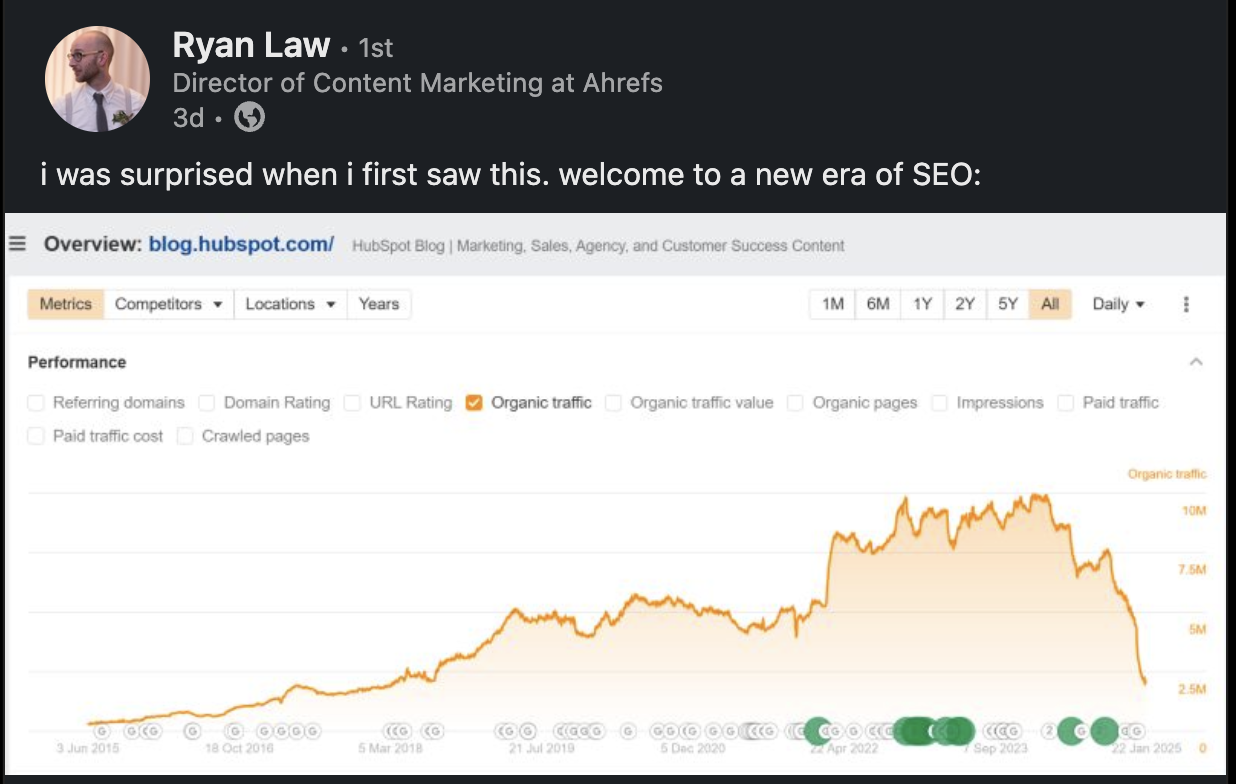
Even though these traffic drops may cause some anxiety (especially when you have to report on them to leadership teams), you first need to ask yourself:
Did I actually care about this traffic in the first place?
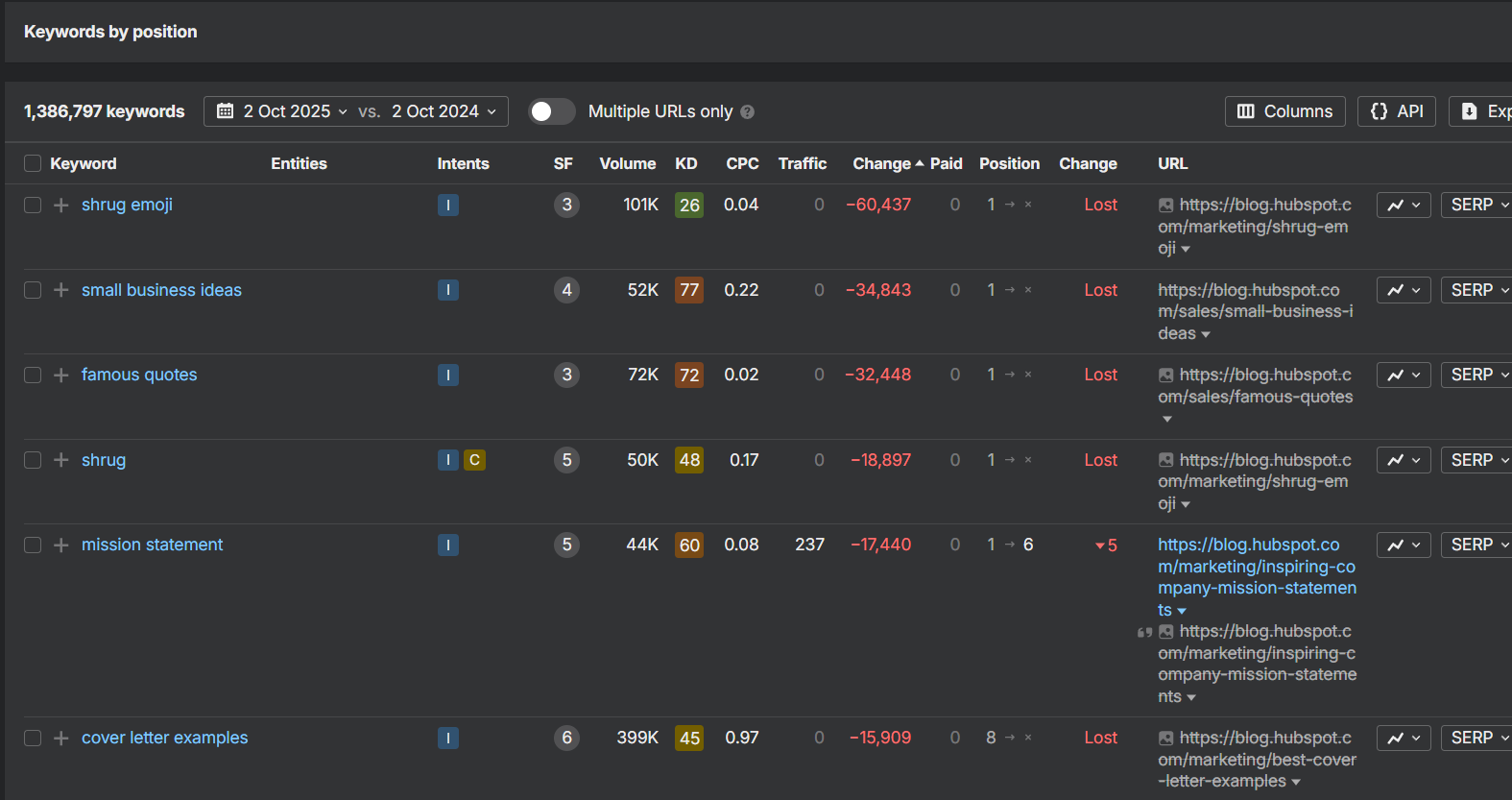
If you’re HubSpot, this is probably an easy one to answer.
I’m sure they’re not losing sleep over queries like:
- Shrug emoji
- Famous quotes
- Cover letter examples
So while the above graph paints one picture, the actual reality is that HubSpot is only losing visibility on keywords they had no business ranking for in the first place.
These keywords had absolutely nothing to do with HubSpot’s core product and only served the purpose of ranking and driving vanity clicks.
I won’t even say that they helped build brand visibility or recognition here, because no one searching for “shrug emoji” is possibly going to tie that experience back to a customer relationship management software.
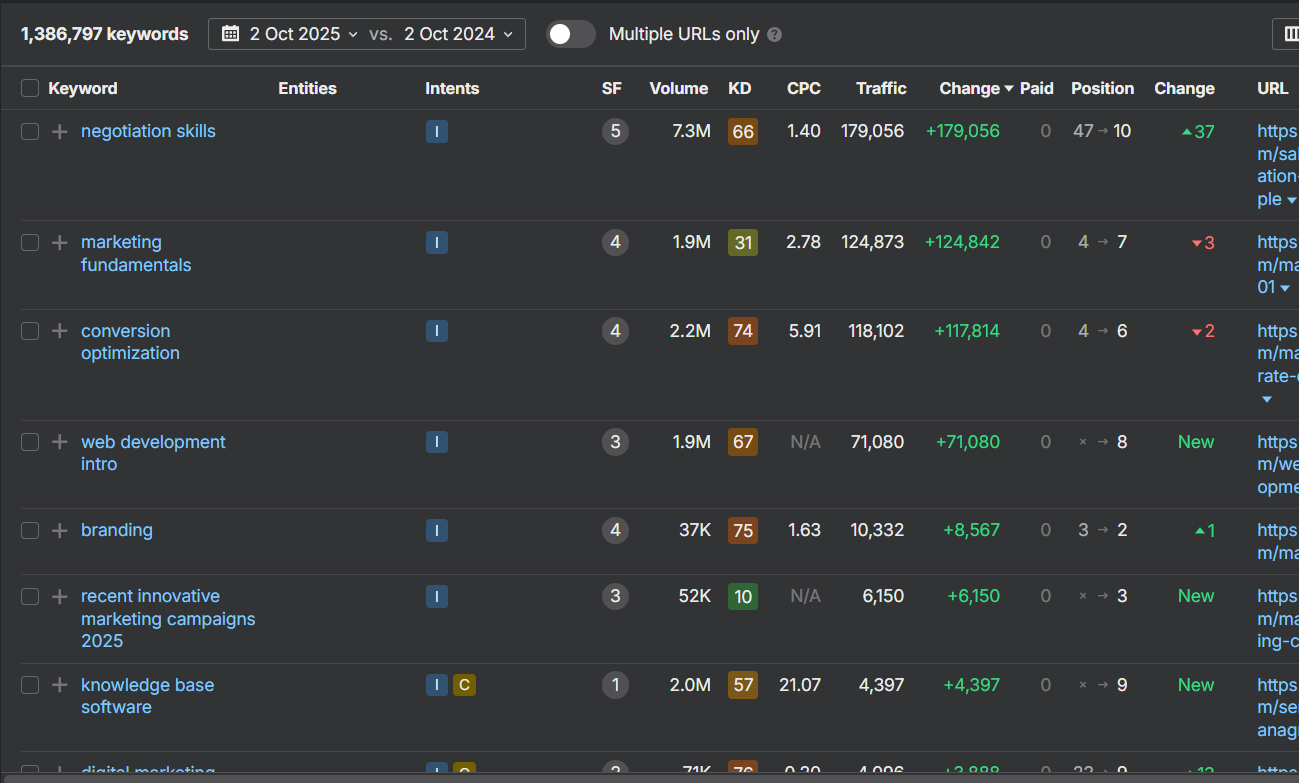
This type of spray-and-pray approach by using definitions, glossary pages, and irrelevant “how-tos” (that was made popular by HubSpot) was always destined to fail.
But when we look at the keywords HubSpot is seeing growth on, it paints an entirely different picture.
They’re seeing large movements on keywords like:
- Marketing fundamentals
- Branding
- Conversion optimization
- Knowledge base software
Searches that align more closely with what HubSpot offers and can be used to highlight HubSpot’s features.
So, like HubSpot, you need to ask yourself whether those keywords you’re losing visibility on even mattered in the first place.
And if the keywords/queries you’re seeing growth from make up for it.
One way you can check this is by looking at historical data in GA4/GSC and comparing it to the last 3 months.
Ask yourself:
- Have your conversions from organic changed despite the hit to traffic?
- Did the pages that drop in traffic ever drive conversions for you
- Have your prospects ever referenced these pages during discovery calls
That should give you an obvious answer on whether these content topics were worth caring about in the first place.
Chances are, they weren't.
Pro tip: either way, traffic has always been a flawed way of looking at SEO performance. It can be helpful when viewing branded vs non-branded traffic, but it’s so so so important to look beyond just traffic performance and look at what’s driving traffic instead. And of course, conversion tracking should be a major part of this as well.
So why am I losing this traffic to AI?
So you know what’s losing traffic.
Do you know why you’re losing that traffic?
Sure, it’s AI that’s causing it. But do you know how AI is specifically causing your website traffic to drop?
There are a few reasons here:
- AI Overviews Are Killing Click-Through Rates
In some cases, Google’s AI overviews are reducing CTRs by as much as 70%. Instead of clicking through to websites, users are simply reading the AI-generated summary (that’s pulled from the ranking results) and moving on. - Users Prefer Quick Answers
Users don’t want fluff anymore. Skyscraper content worked before, but when paired with user behavior, no one wants to read a 5,000-word article on “what is email marketing.” They would rather have an LLM explain it to them in a few words. Think about it like Gen Z’s “this could’ve been an email.” So in most cases, users are either summarizing longer documents through AI overviews or other LLMs like ChatGPT or Gemini. - Top-of-Funnel Content Is Most at Risk
When you pair the two trends above together, you’ll see that ToFu content is getting absolutely demolished. Like with HubSpot, they’re losing out on traffic that they had no business ranking for anyway. Users don’t want to read fluff pieces anymore, and now they have a reason not to by just going straight to an LLM.
The reality is: If your content’s only purpose is to provide a quick definition or a surface-level answer, AI will do it faster, cleaner, and more directly.
Those clicks are gone, and they’re not coming back.
Not that you should want them back anyway.
Some SEO approaches just need to change
You know that AI overviews are eating your traffic, and why traditional SEO ToFu content pillars are the first victims.
Now, you need to change your strategy to complement this new era of SEO.
Move away from the SEO silo thinking; view the whole ecosystem instead
One of the biggest mistakes I see companies still make is treating SEO as a siloed channel instead of a channel that operates in a larger marketing ecosystem.
SEO does not exist in a vacuum.
A user isn’t just Googling a query, landing on your page, and converting in one step.
Their journey is much more complicated, involving multiple marketing touchpoints and influences before making a final decision.
Touchpoints that would never even show on a clear attribution report.
Platforms like Reddit, LinkedIn, podcasts, and YouTube can all influence your audience’s search behavior, and you wouldn’t even know it unless they told you during a discovery call.
Are they:
- Being recommended tools or solutions on Reddit?
- Getting hit with ads on LinkedIn around that pain point?
- Are people in their network or communities talking about specific tools?
Those touchpoints can all influence:
- What they search for: Are they already solution/problem aware, or are they problem unaware?
- How they’ll perceive your brand when they come across it: Will these users actively seek your name out on the SERPs if they see it?
You can use SEO to capture lower funnel searches like “Best CMS for property managers,” but users have already been influenced by other marketing (or even sales) touchpoints to get to that point of searching for solutions.
So, when you set your SEO strategy, don’t only see it through the lens of an SEO.
Instead, think about how it fits into the larger marketing ecosystem and how you can influence other distribution channels while using SEO to capture those later-stage funnel leads.
Invest in influence, not just optimization
SEO is no longer solely about “optimizing.”
While optimization is still a part of the equation through content, links, and technical SEO, influence goes much further in the full marketing ecosystem to affect performance beyond just visibility on search engines.
With optimizations, you are optimizing with the intent of making your content or site more relevant around a query or topic. You’re hoping that by doing X, it will lead to a Y result.
Influence is a bit more of a murky journey. Instead of optimizing for a direct result, you’re focusing on other marketing channels that provide a secondary benefit to your SEO.
It means taking a holistic approach to marketing that allows you to extend your reach across distribution channels while still supporting SEO in the process.
You’re getting more bang for your buck, essentially.
So a few examples of this could be:
- Your sales team asking for a competitor comparison asset: Not only does this support your sales team, but this content can be indexed by search engines and is likely sought after by your prospects when they’re in the final stages of their journey.
- Brand marketing making you a sought-after brand: The more established and known you are in a category, the more likely users will either search for your brand specifically or click on your results over the other lesser-known names. I do this quite frequently with Ahrefs since I generally prefer their content. Ahrefs has built a brand on quality content for SEO through email, video, and their blog, so if I ever see them on the SERPs, I will seek them out above the others.
- Press = Authority: While it’s not directly link building, if you’re getting press online, that likely will come with a backlink or an opportunity to ask for one. Instead of spending $$$’s on link building per month, you’re letting your brand develop links naturally. So, whether it’s press from industry research or thought leadership, you’re building your authority organically that translates into both industry and site authority.
This stems from effective marketing overall, so that means channels like these can impact your SEO indirectly:
- Brand marketing
- Product marketing
- PR
- Sales
So all of these direct marketing activities now carry the indirect benefit of increased visibility for SEO and AI search.
Which, again, is a major reason why you shouldn’t view SEO in a silo.
Okay, that’s great, but what should we be doing instead?
You don’t need to do anything drastic to overcome traffic loss from AI overviews and LLMs.
Instead, you need to understand what tactics will have the most longevity for both retaining visibility from SEO and engaging your audience.
Here’s what that looks like.
1. Find the content assets that will be AI-proof
Now, there are just some content types that AI can’t replace.
Content that users can’t access anywhere on an LLM.
I usually bucket them into two categories:
- Expertise that an LLM can’t replace
- Product-led assets
With these two content types, users are more likely to seek out your content rather than head straight to an LLM.
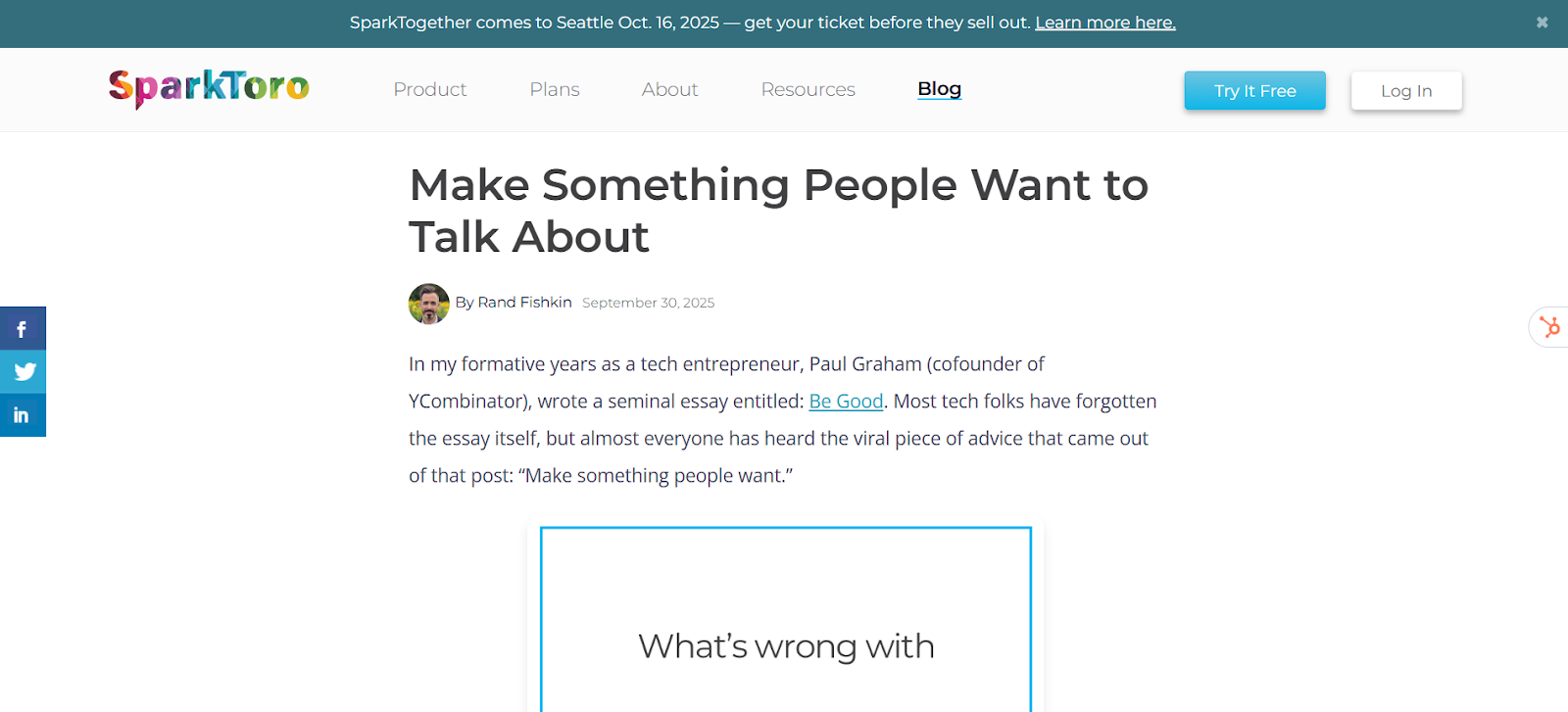
Expertise-driven content is very straightforward; it’s content that:
- Can only come from someone well established in an industry (think your CEO or CMO)
- Can only be explained through personal experience
- Offers a fresh or unique take on the status quo of your industry
This content will always carry weight, beyond just SEO through social, email, and webinars.
The second category, product-led assets, are pages tied directly to your product that give users a free preview of a specific use case.
A good example of this would be Ahrefs' “Backlink Checker,” which allows users to check who links to their site entirely for free.
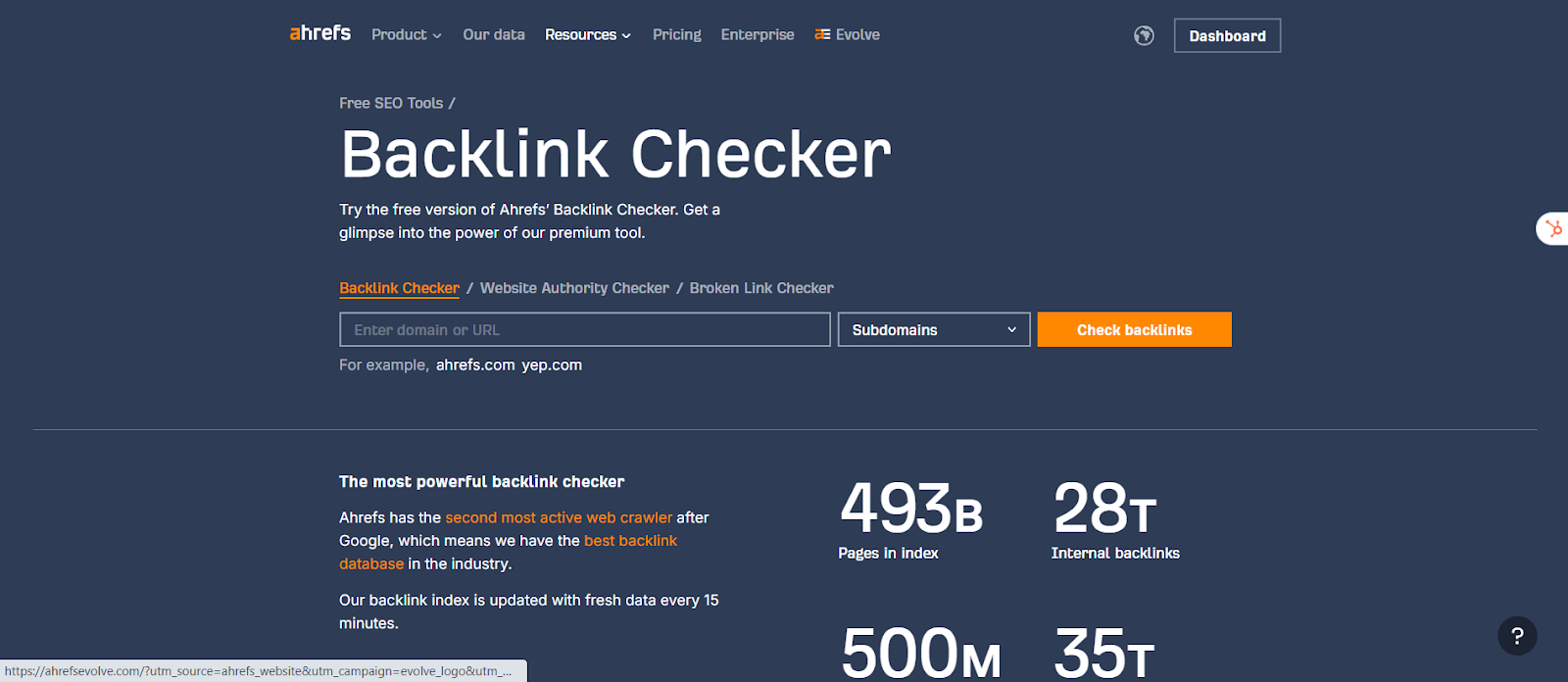
This isn’t limited to one page either; Ahrefs has multiple ways you can use their tool for free:
Obviously, this has a freemium element to it (where users can’t see all of the backlinks and have to create a starter account to see more), but this is exactly the type of content that:
- Creates a freemium pipeline of people building consistency and repetition with your product
- Is not something that an LLM can do directly
- Can be scaled with programmatic SEO
With these product-led assets, you can:
- Capture users searching for a product like this through Google Search
- Have users seek it out directly or use it daily once it becomes baked into their workflows
The more they use it, the more likely they are to upgrade to a paid plan once they decide they need more features or want full access to that use case.
However, let’s not forget that this page is still dominating through organic search, driving over 300,000 clicks per month.
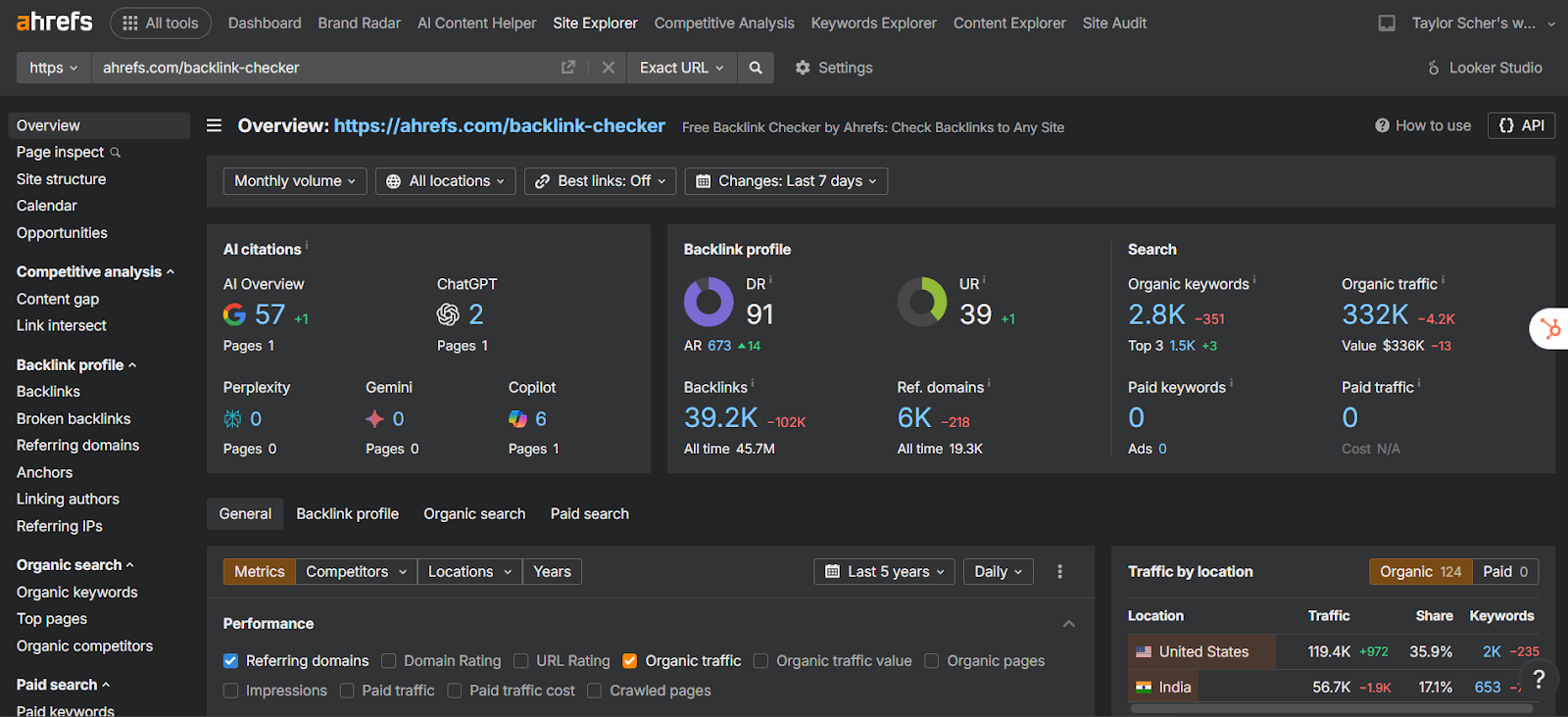
Which comes from both branded and non-branded terms (branded since users built recognition by using this product).
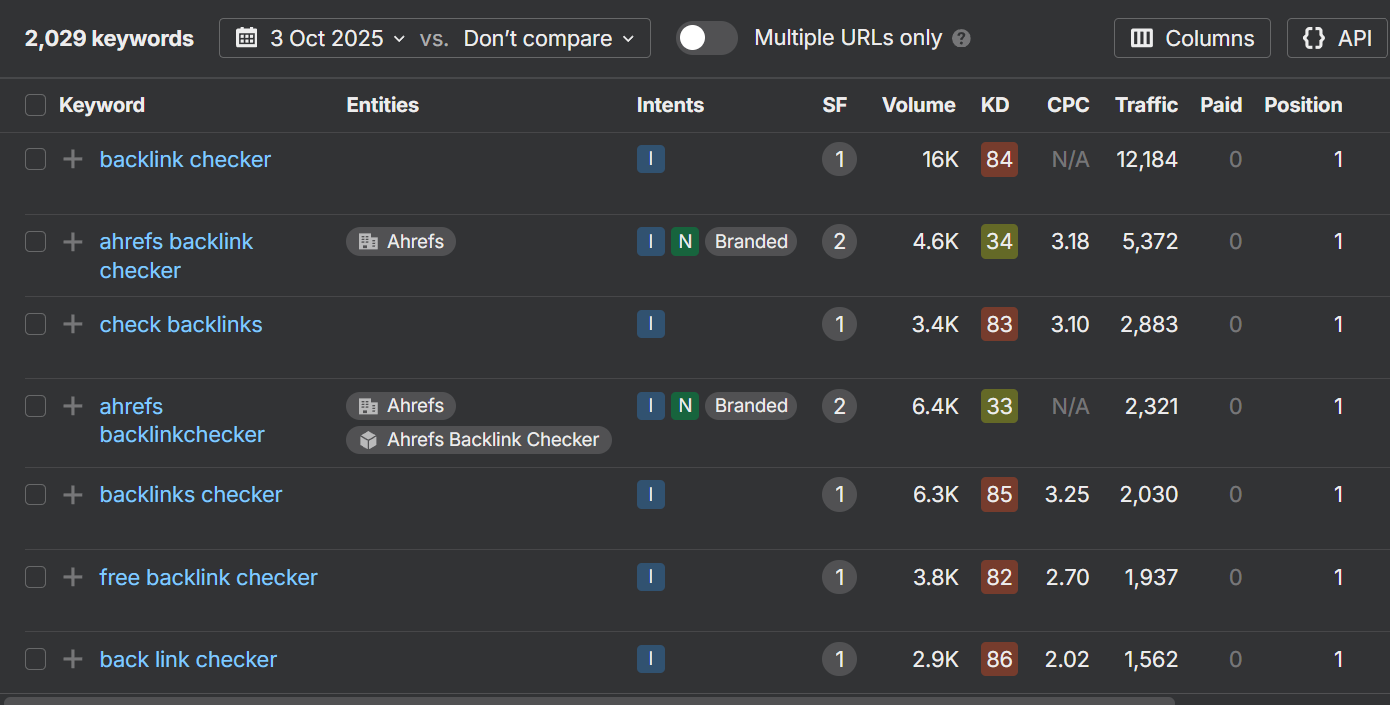
These free product-led tools obviously work best as an AI-proof asset, but other AI-proof assets include:
- Templates that automatically get you situated within the product (ClickUp does this exceptionally well with their dashboard templates)
- Calculators (although I will argue that LLMs make it easier than ever to build this)
- Video content. AI hasn’t come close to replicating branded creative videos, so for the meantime, this asset is untouched. Especially when you consider all the different ways you can repurpose video content.
- Industry-driven research, which gets you clicks and press
Whatever the content type is, ask yourself first whether this is something AI can do.
2. Still spend time on your BoFu content
BoFu content remains, to this day, the most effective way to generate leads from your SEO strategy.
Fortunately, so far, it has remained relatively untouched by AI.
This is because, for real lower funnel searches, users aren’t just relying on AI to make all their decisions.
In fact, we’ve already seen data that shows ChatGPT is enhancing users’ search behaviors, rather than replacing them.
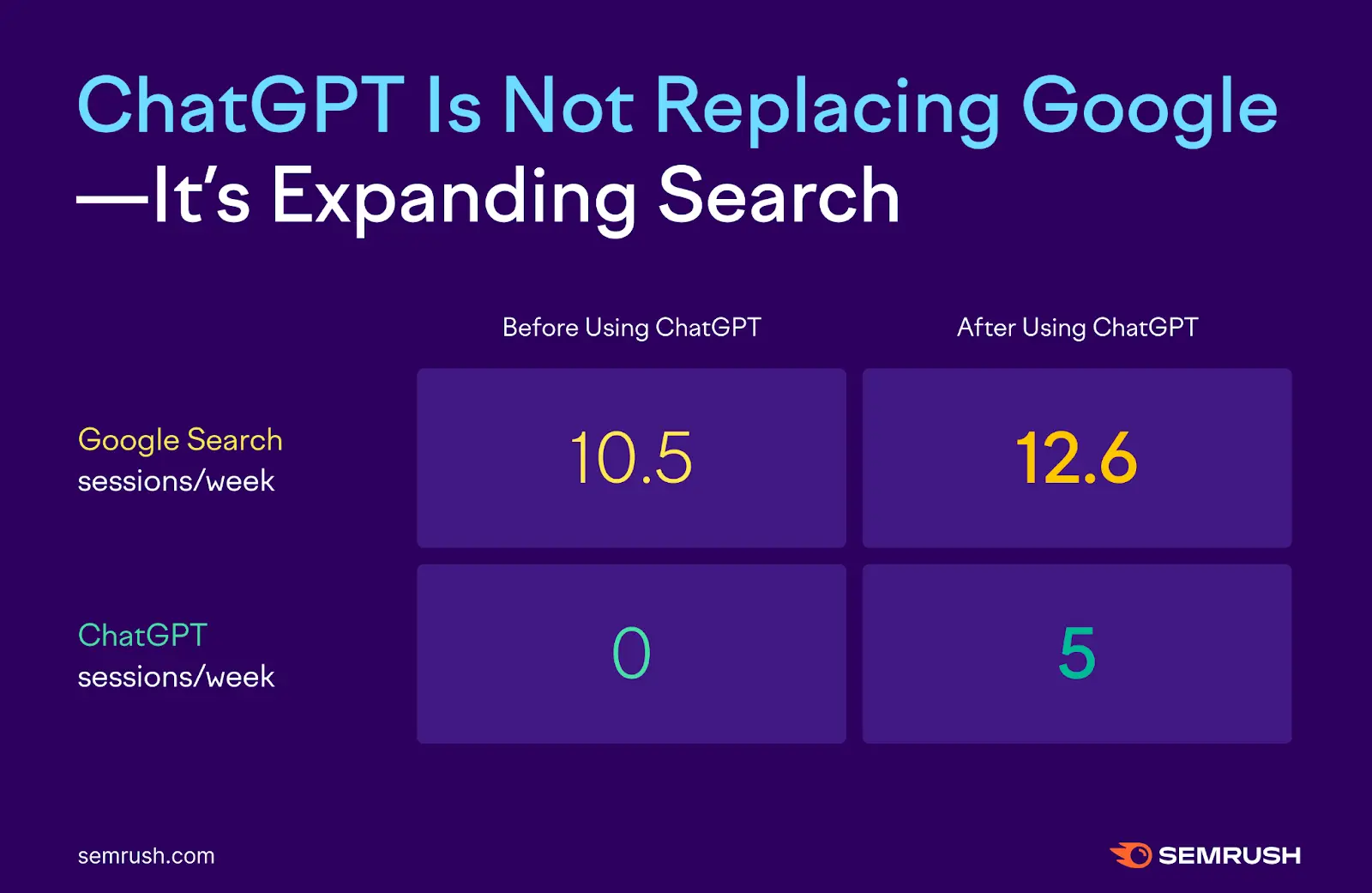
While AI may influence their buyer’s journey, they won’t rely on just one platform to research a product.
That includes:
- G2, Capterra, TrustPilot
- Reddit and other niche forums (Reddit even estimates that 88% of social media users turn to Reddit for purchasing decisions)
- BoFu content, whether it’s from your site or affiliates' sites
All of these avenues are used to help inform a user's purchasing decision beyond just using ChatGPT.
That’s why the absolute worst thing you can do is treat BoFu content as another task.
If you want users to consider your product, then you have to give them the right ammunition to research your product.
Don’t use a listicle as a way to say you’re the best overall and your competition sucks.
Instead, keep the user in mind and help them:
- Understand how your product is different from the competition
- What your strengths and weaknesses are
- What your competitor’s strengths are
- What situation your product would be right for
When you treat BoFu content as a way to educate instead of sell, your audience is much more likely to listen to what you have to say.
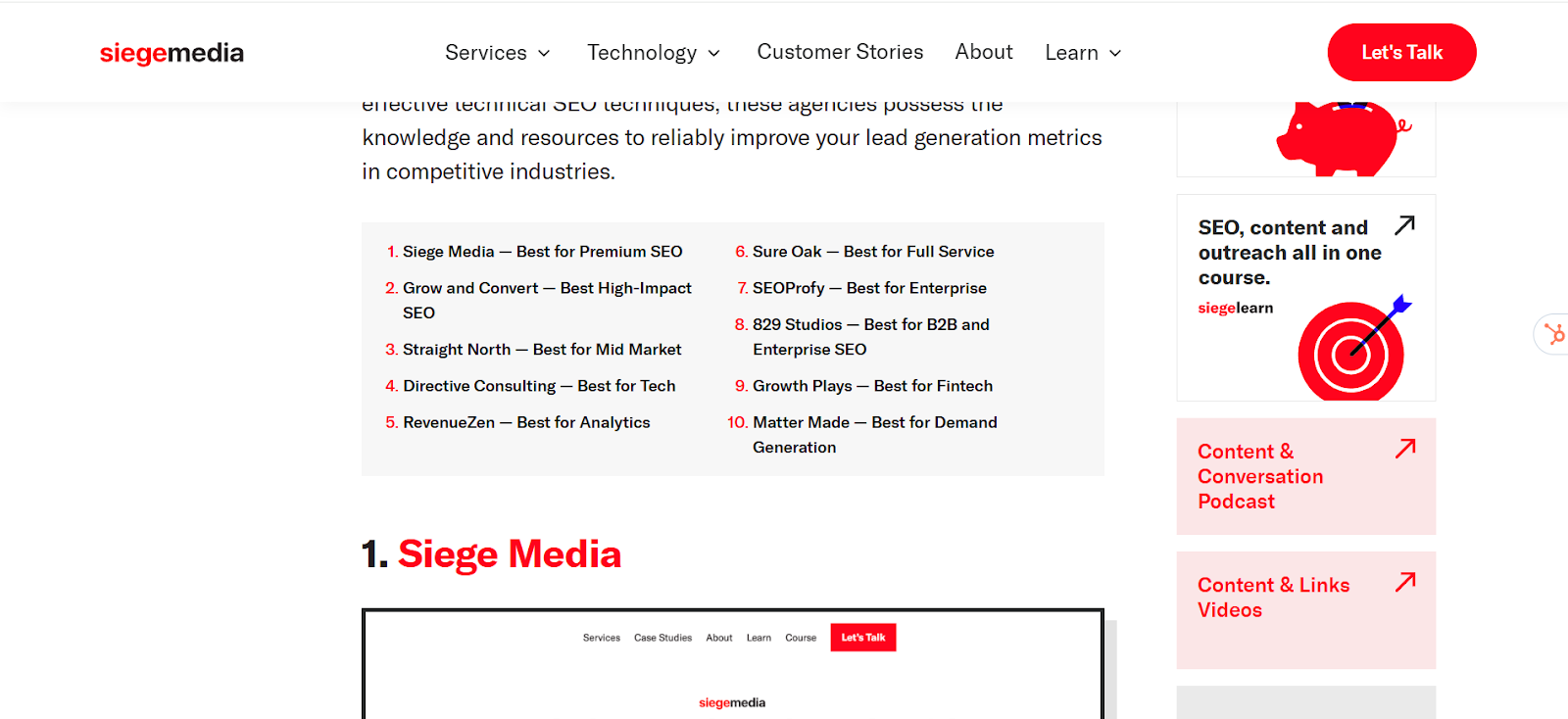
Users want a genuine understanding of how your product works versus your competition.
What makes this content AI-proof is that:
- Users likely want to read a firsthand account of someone’s experience with a product. What did they say they liked and didn’t like?
- Users know an LLM can hallucinate, so they would rather read from a source they can confidently believe is real.
- These listicles are generally more detailed than a comment you’ll read on Reddit, so users will read them to get a complete understanding of all the potential products and their capabilities.
- Search engines are still ranking first-party-created listicles alongside affiliate and review platforms.
Give users the information they need, don’t just use it as an opportunity to sling mud at the competition and make yourself seem like the perfect product.
Let your BoFu content influence their journey, not just force it.
To do this, make sure you have full coverage of your BoFu content, including:
- Category listicles: Best [category] tools for [use case], Top [category] platforms for [industry], [Category] software for [team size]/[role]
- Competitor alternatives: [Competitor] alternatives, Best [Competitor] alternatives for [use case], [Competitor] alternatives for [persona]/[industry]
- Competitor comparisons: [You] vs [Competitor], [You] vs [Competitor] vs [Competitor 2]
And the best part about all of this is that this type of content directly impacts how LLMs reference your brand, too.
If your product has clear positioning in a specific category/niche, LLMs are more likely to reference your name as a relevant option for that category.

So not only is this content mostly AI-proof, but it’s a literal cornerstone of how you optimize for LLMs.
3. Your audience still needs answers to their problems; MoFu content is how you help solve that
One of the worst habits people developed with SEO is starting entire strategies with keyword research.
Don’t get me wrong; keyword research is a core part of SEO.
But people’s obsession with data-driven tactics has caused them to completely overlook why they’re doing keyword research in the first place.
It should never have been about “finding a keyword with high search volume and writing mediocre content around it.”
This type of thinking is exactly what is causing this click apocalypse, many sites are seeing (**Cough** Shrug Emoji **Cough**).
Instead, keyword research should’ve always been a supplementary tactic to audience research.
So before starting with any keyword research, that means asking yourself questions about your audience, like:
- What does my audience care about?
- What problems is my audience facing?
- Is their problem relevant to the solution I provide?
- Can I create content that helps them solve this problem?
That is step 1 and should always be step 1.
Once you have these insights, whether it’s from sales calls, discovery calls, or interviews, you can then use a keyword research tool like Ahrefs or SEMrush to validate whether your audience is actually searching for it.
We call this a search market fit.
But you're not limited to using keyword research tools to validate your audience research, either.
You can even use Reddit as a tool to validate whether this is a common problem for your audience.
If your prospects are repeatedly posting about this problem, it should be a sign that this is a serious issue for them.
A problem they have 0 idea how to solve.
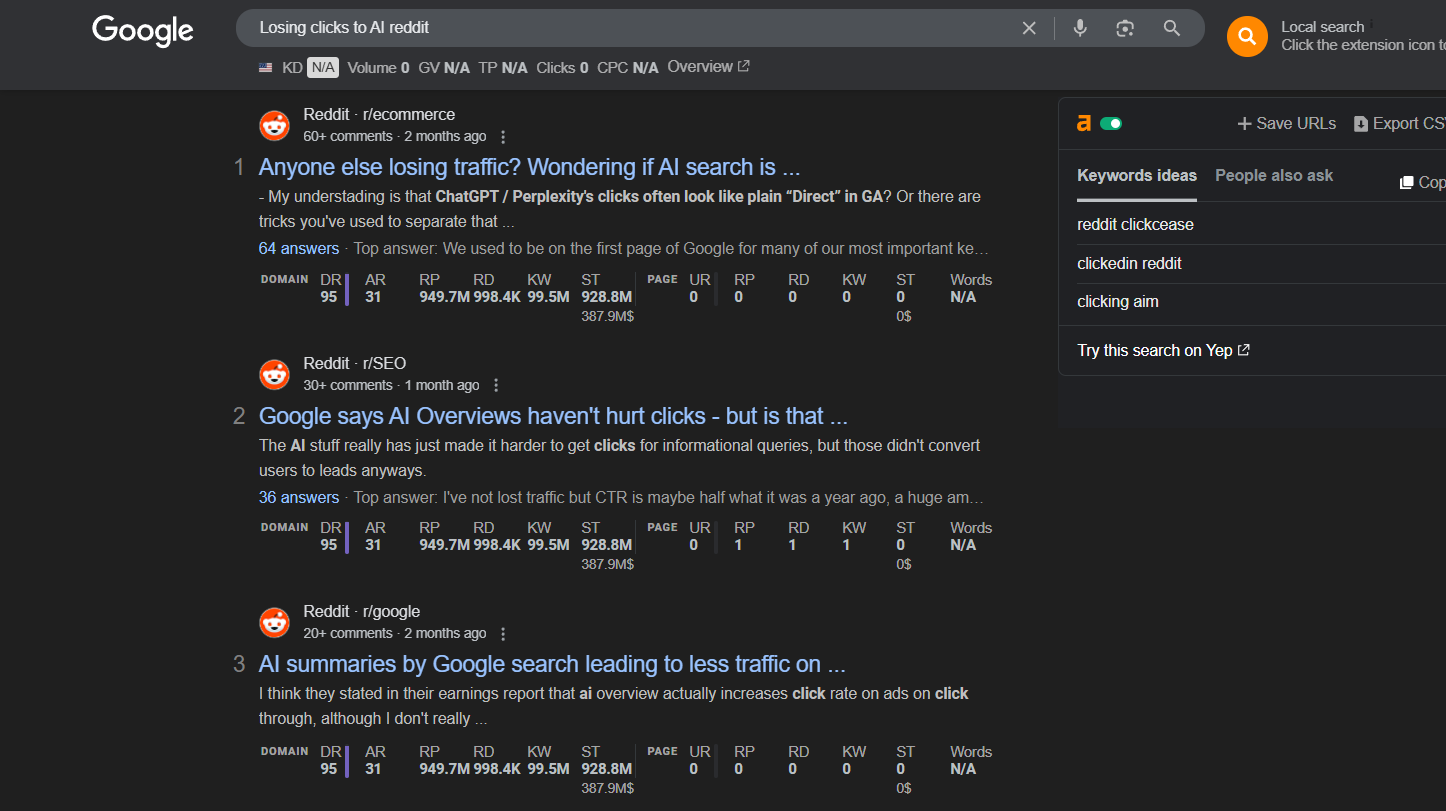
Now, what’s the best thing to do for your audience?
Help them solve that exact issue.
You can position your product as a solution (as long as it’s genuinely a solution), along with other routes they can take.

Mix that in with content coming straight from someone with a personal brand, and you’ll have content that can be:
- Distributed and sought after on other channels (social, email, etc.)
- Ranking and found through organic search
That is quite literally what I’m doing with this article here.
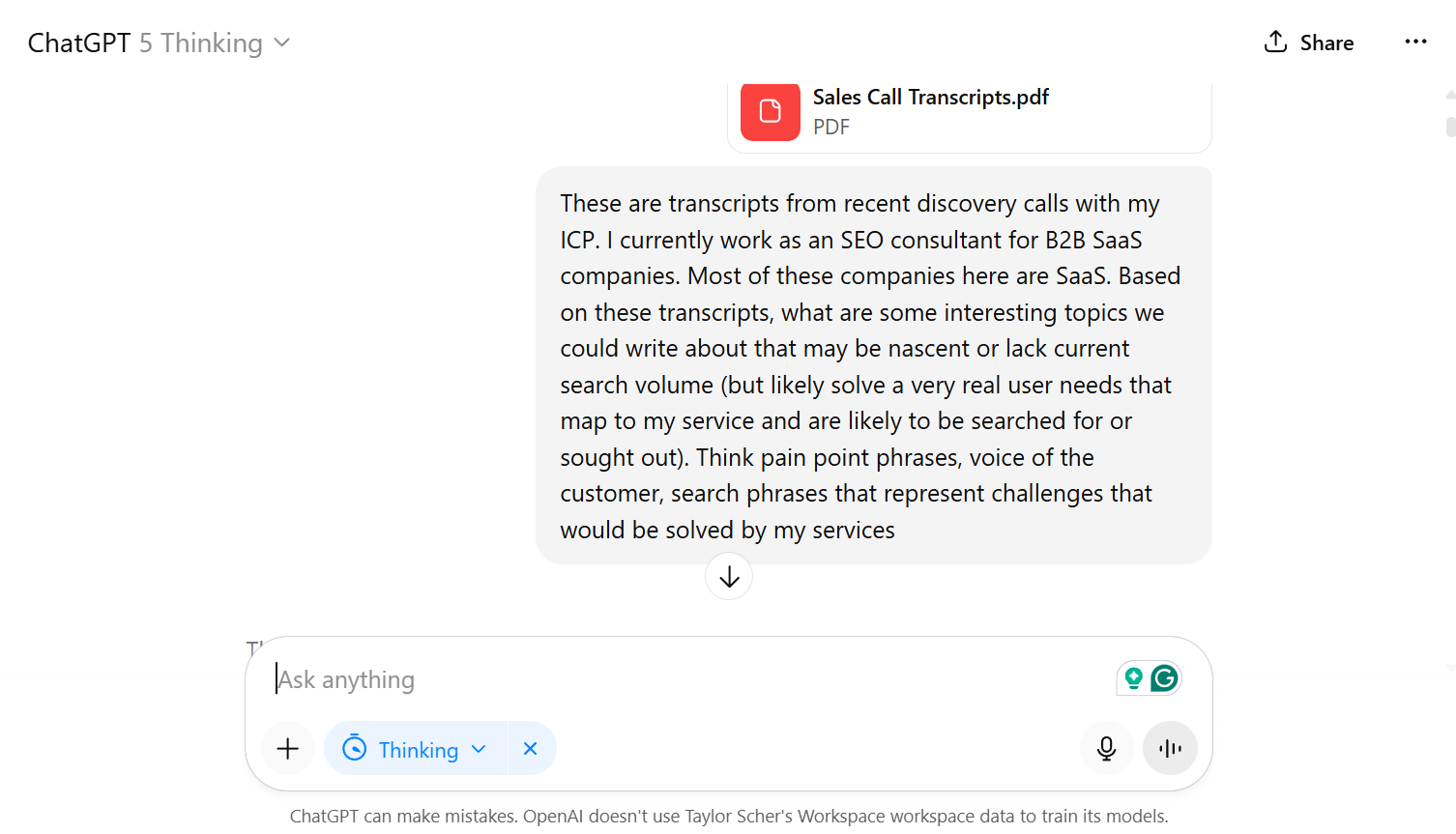
I took 8 of my last discovery calls, plugged them into ChatGPT (credit to Alex Birkett for the prompt), and had it aggregate the most common pain point my prospects were mentioning during those calls.
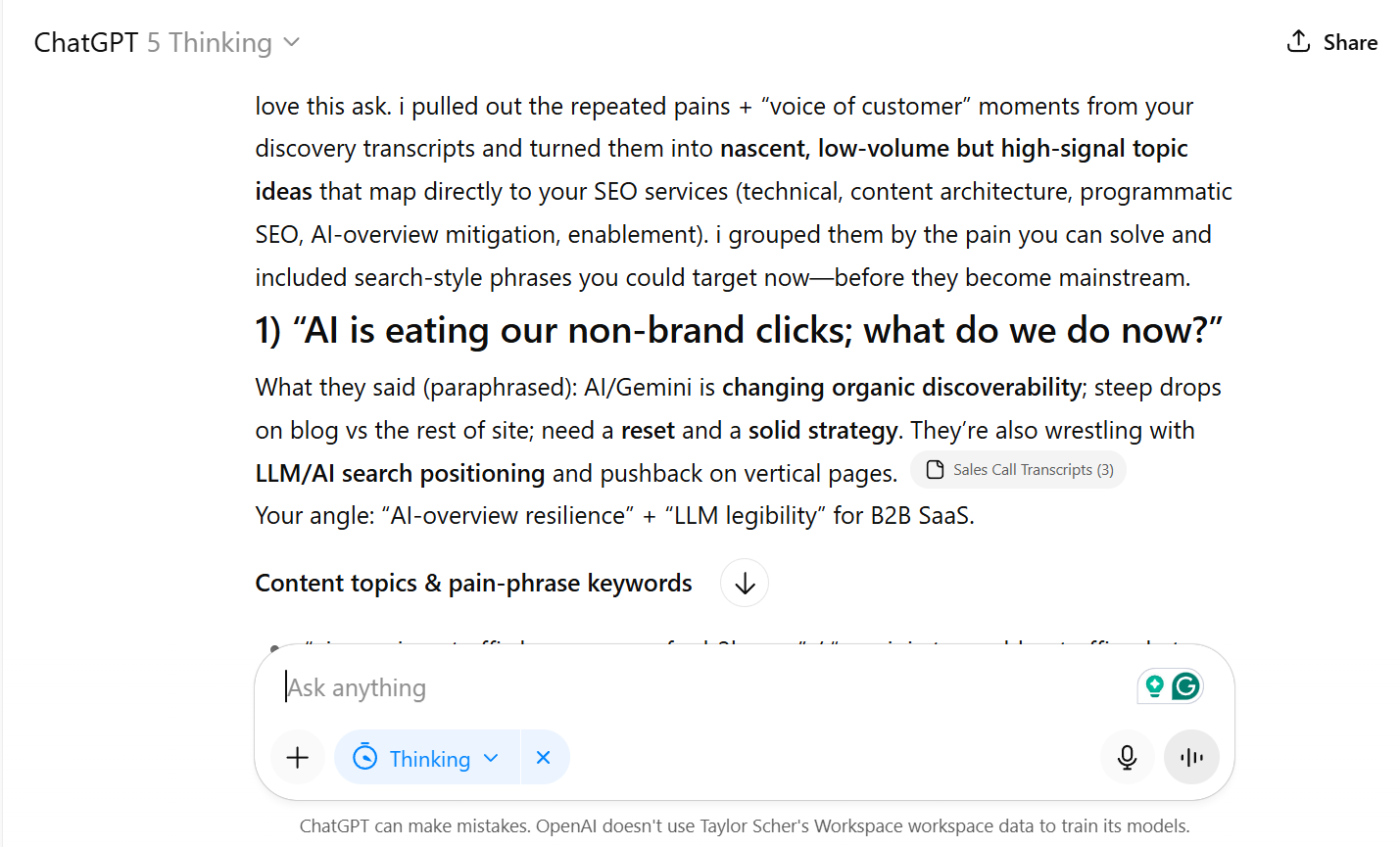
So, to the surprise of no one, the number 1 listed problem on all of those calls was “AI is eating my traffic, what do I do now?“
In this case, I couldn’t care less if this topic has a monthly search volume of “100,” what I care about more is addressing a genuine problem my ICP is facing and giving them an idea of what they can do to fix it.
I might see if there’s any search visibility I can capture for it, but since I have other distribution channels at my disposal, I don’t have to make this an “SEO-specific” article.
If this article ranks, then great, but what I care about more is having this article solve a very real problem many site owners are currently dealing with.

Are you leading with a solution to a problem or explaining a job to be done?
Or is your article created with the sole purpose of ranking on Google Search?
That’s how you have to think about your MoFu content.
4. Show some love to your landing pages
I’ve always thought landing pages (i.e, solution/feature/industry/use case) have been undervalued.
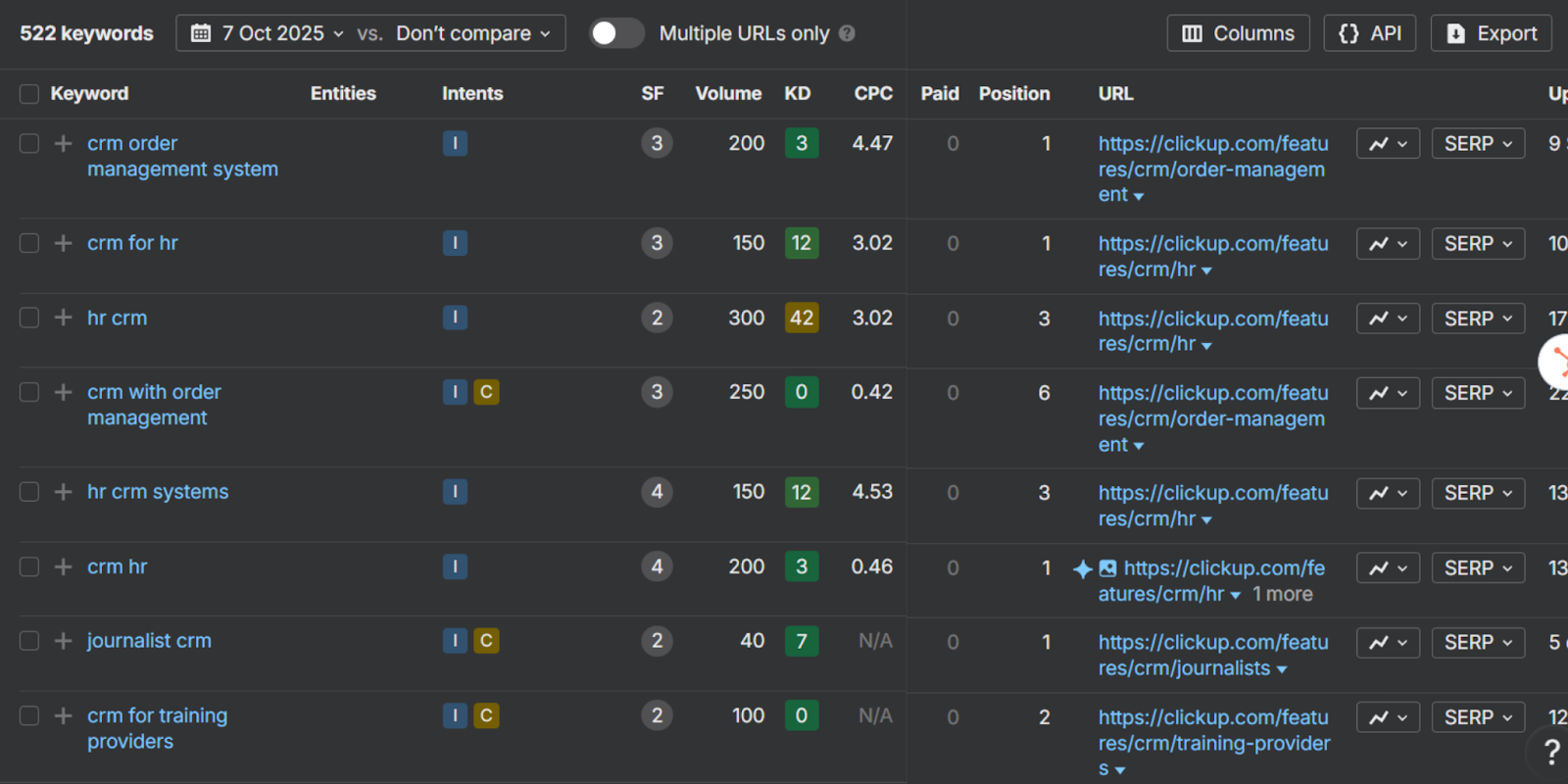
But with AI continuing to eat up blog content traffic, these pages are a must to optimize for now.
As I mentioned with BoFu content and how we want to educate users about our product, landing pages serve the same purpose.
However, this time, you have more flexibility to show off the product in action, whether it’s product screenshots, FAQs, videos, gifs, etc.
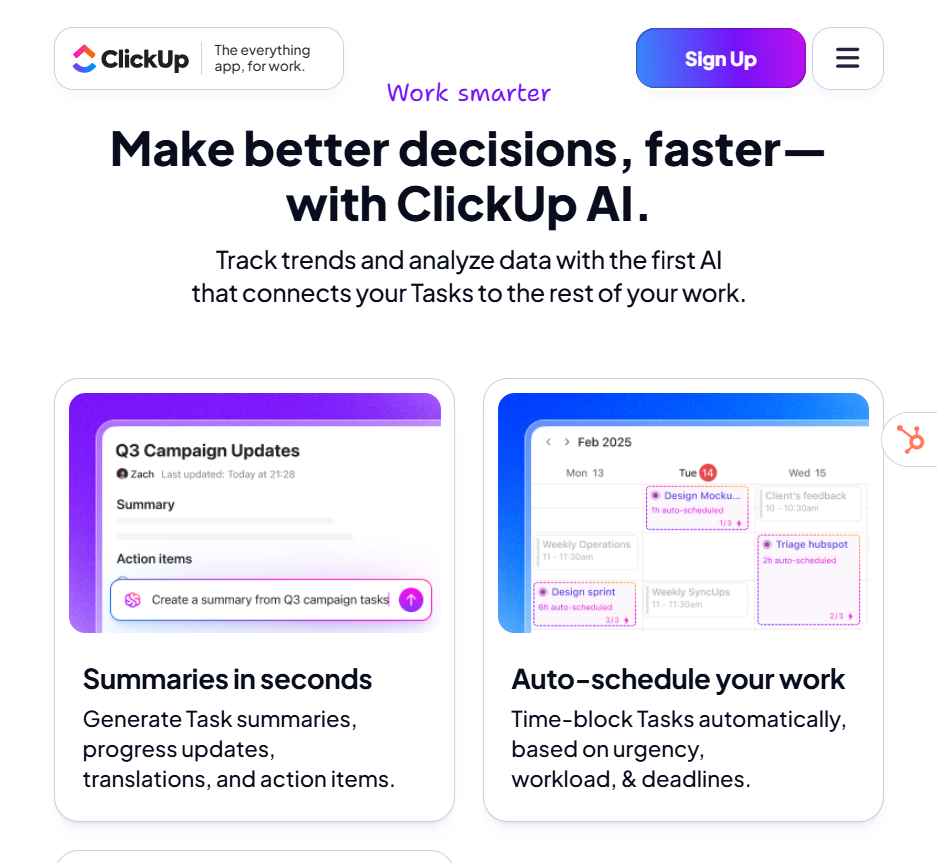
You’re not just limited to a blog article.
You have full range to show off your product, which is why a user is on that page in the first place.
But the real opportunity is how these pages are found.
Sure, I could search for “best audience intelligence tools.”
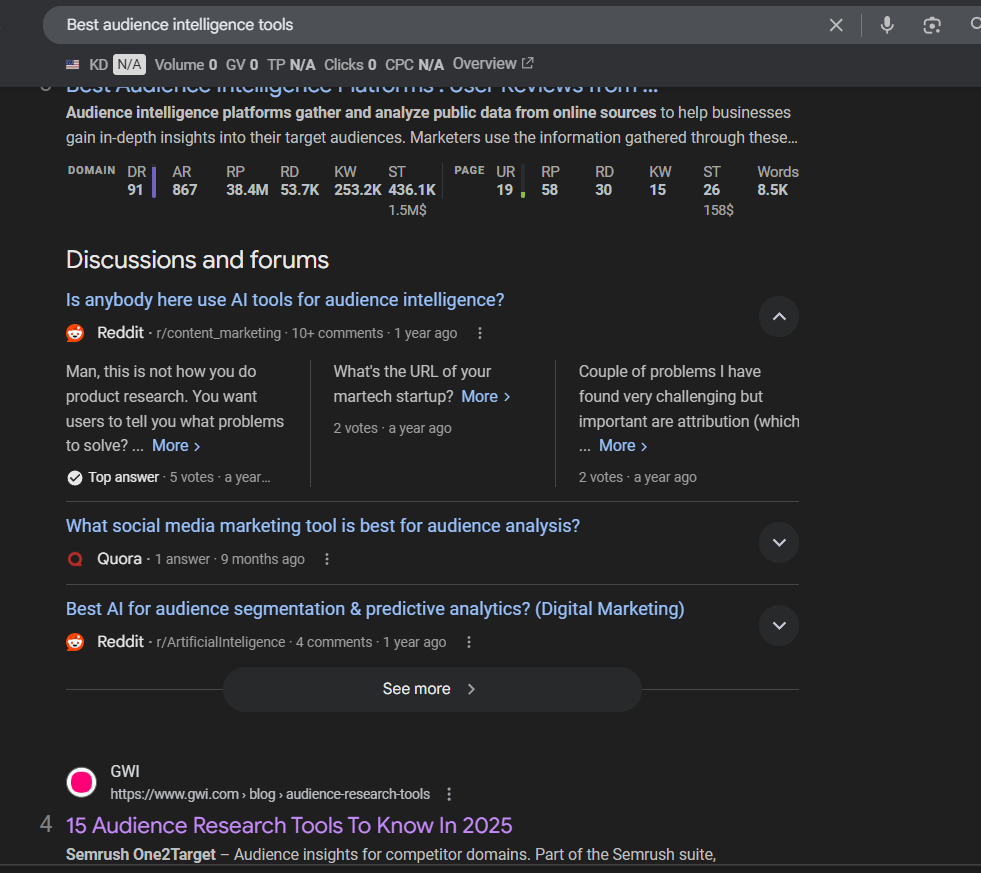
But if I search for just “audience intelligence tool,” the SERPs will have an entirely different intent and mostly show landing pages. Whereas the former shows listicles and forums.
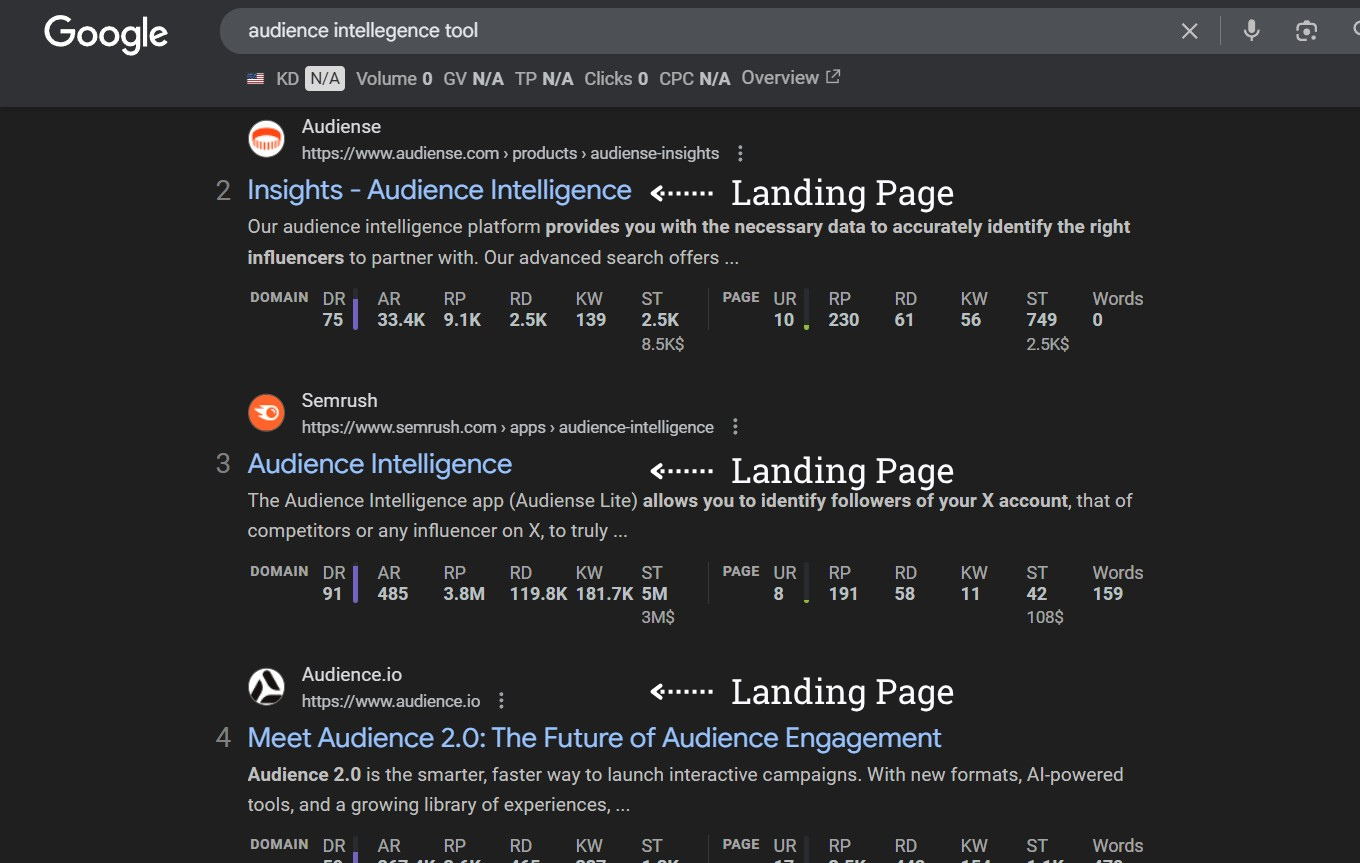
I’d argue that these pages are what should absolutely be optimized first before you start any blog content.
Just think about it: would you rather bring in visibility for a blog article like “What is Audience Research” or a landing page optimized to drive conversions?
Not to mention, these pages are significantly easier to update and optimize.
All you need to do is:
- Update your title tag and H1: Make sure it has your main software/tool/app/platform keyword in there.
- Flesh out the details around your product: Outside of the H1 and title tag, forget about anything optimization. Update these pages with the goal of giving a prospect a full roundup of what your product can do with different types of visual product media mixed in.
- Have an FAQ section dedicated to that solution/use case: Again, this is helping beef up your landing page and is an easy way to educate LLMs about your product.
Pro tip: If you’re unsure about what keyword to optimize these pages for, take your landing page URL (or subpath) and plug it into GSC. Add a regex like “Traffic continues to decline across the board with no end in sight, primarily thanks to AI overviews” and see what terms are driving clicks and impressions.
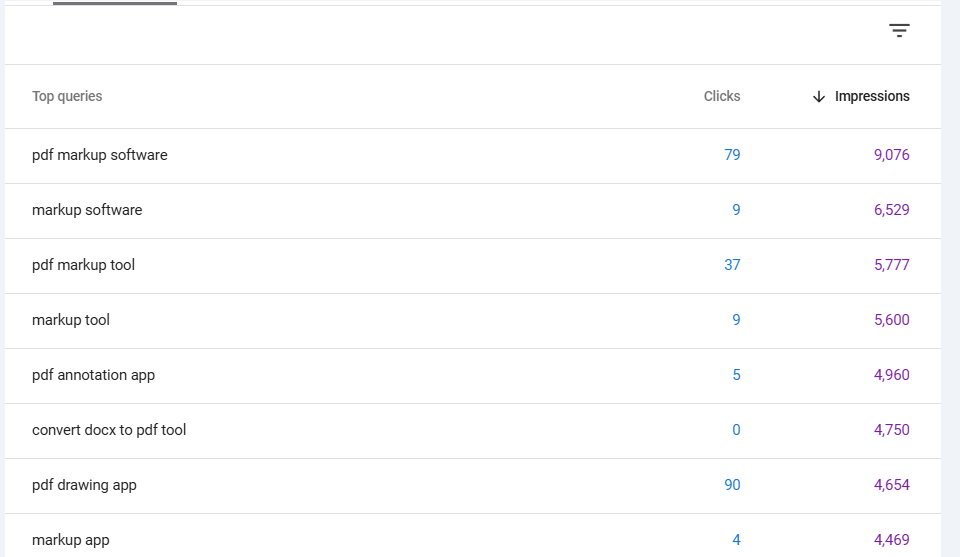
Make sure you perform this check first before creating any additional blog content.
5. Give more attention to video content
Video content is the true AI-proof content asset.
Not only is AI not even close to touching branded video content, but this type of content carries plenty of benefits across your marketing.
You can:
- Drive visibility on YouTube
- Drive clicks from the SERPs to your YouTube channel
- Repurpose your videos into articles
- Have LLMs reference your videos in outputs
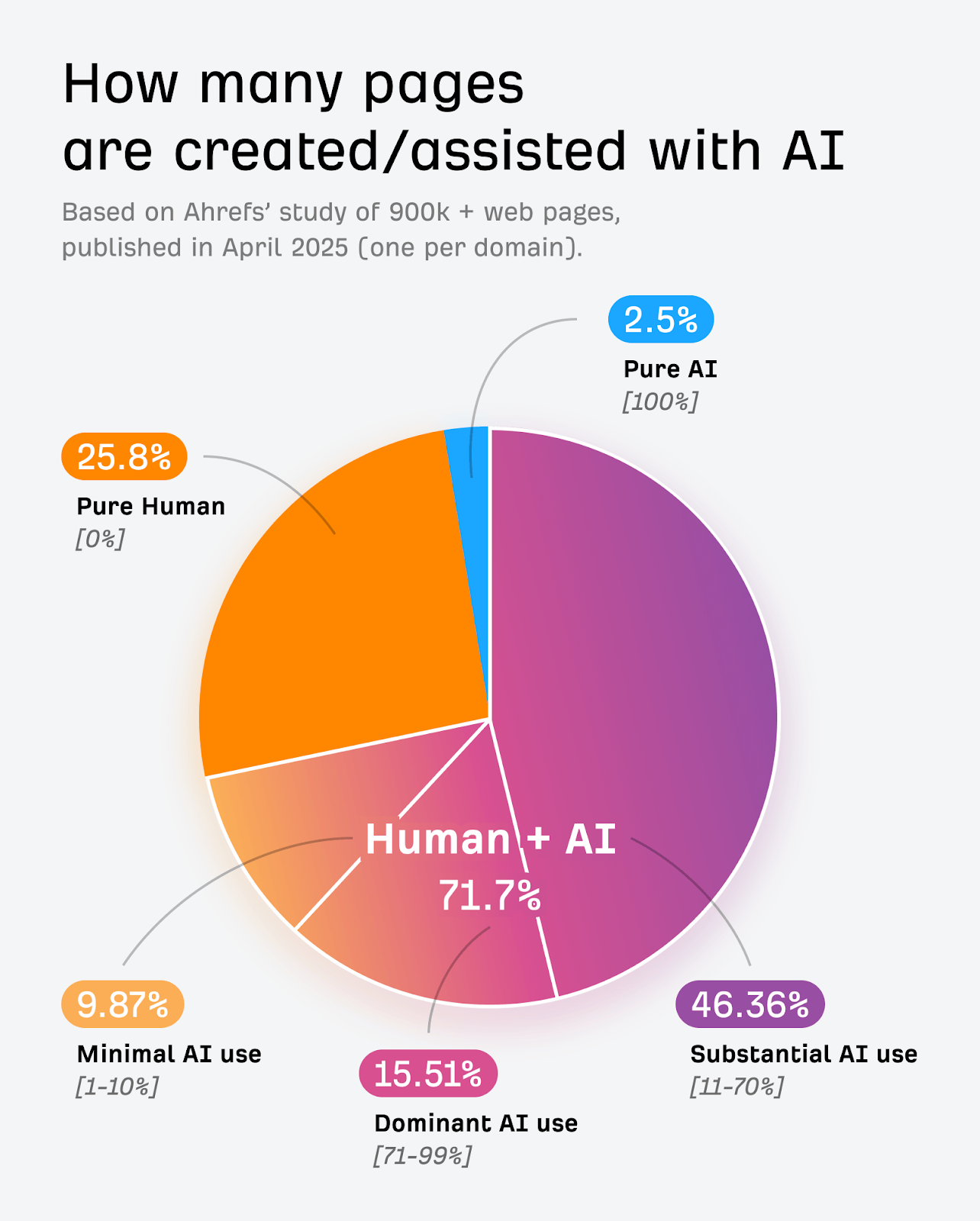
And with 72% of online content being AI-assisted in some way (blog content being the majority of it), showing you’re human might unfortunately become one of the only ways to make your brand stand out online.

Man, I hate where we’re headed 😂
6. Don’t ignore your branded content
I know this article is about non-branded clicks, but Gaetano DiNardi brought up a very solid point in a very similar article to this one (he beat me to it by creating it) that branded content is still going to hold strong with visibility.
As reported by Siege Media, homepage traffic is up 11% because of AI overviews and LLMs.
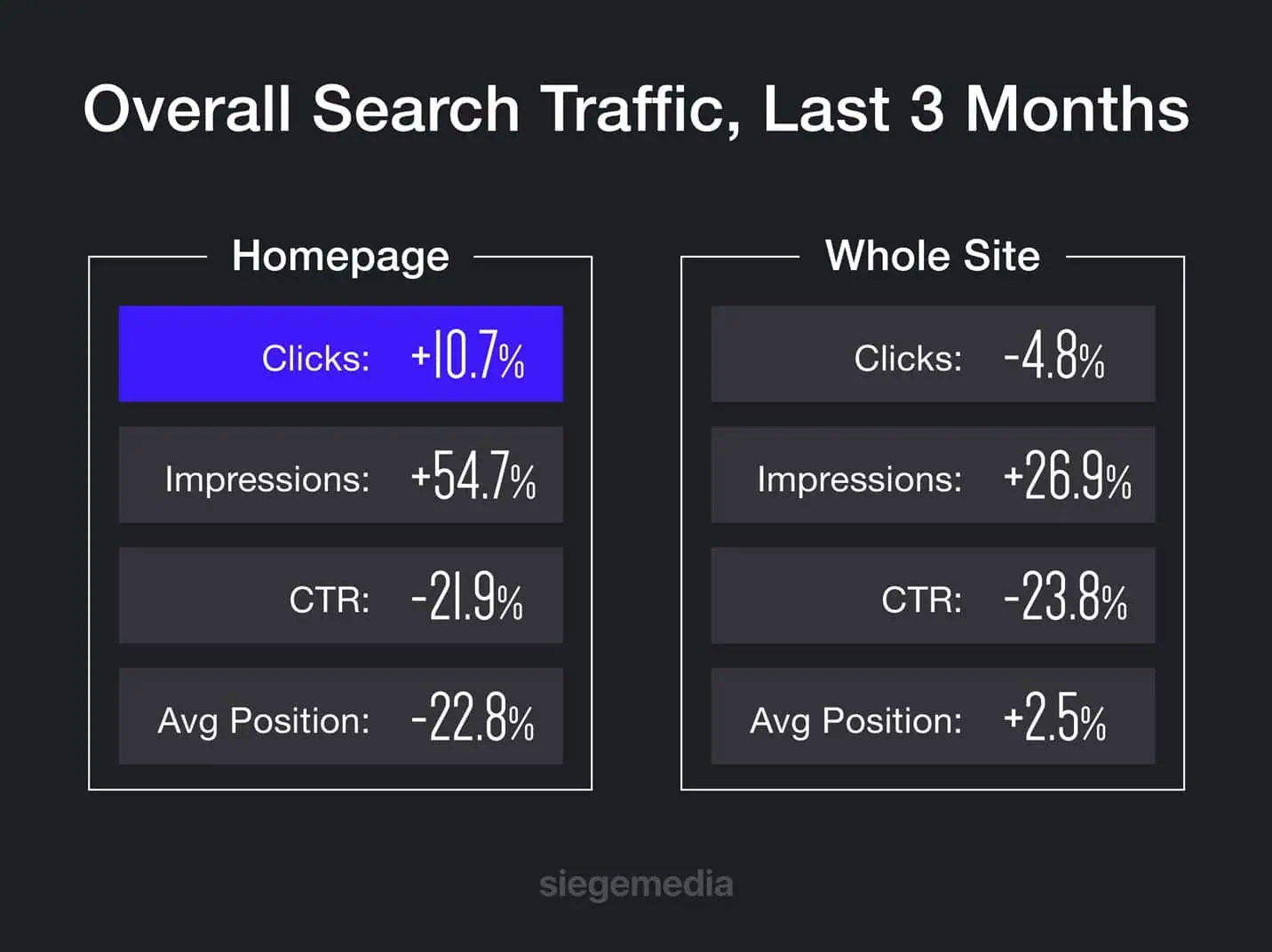
With users able to take the research journey much farther on LLMs before even visiting your site, you want to have your core branded pages optimized for both SEO and CRO (conversion rate optimization) for when they do venture over to your site.
Maybe it’s to look up integrations, a specific feature, or even just check out who you are.
Either way, make sure you have a full breadth of content to cover every single aspect of your brand.
Major takeaway: Don’t get too caught up in the noise, but know when to pivot
So, really, not a whole lot has changed here.
But what you need to understand is that a lot of what you hear on LinkedIn and other platforms is just noise.
If there’s anything I’ve learned over the last few years, it's that the best proof is your own proof.
Rely on your own tests to show you what’s working and what isn’t. Don’t let someone on social media dictate that for you.


.png)

